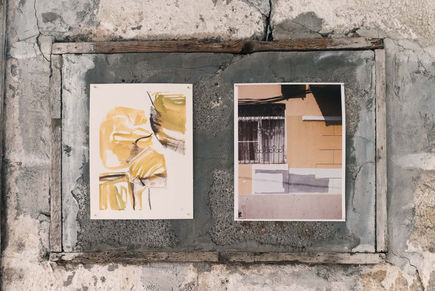The City of the Eye
25 April 2024 - 03 May 2024
Joint exhibition with Alexandra Danzig, curated by Roni Kochavi
Herzl House, Herzl Street 140, Tel Aviv (Israel)
Curatorial Text by Roni Kochavi:
Everyday urban wandering drives the work of photographer Alexandra Danzig (b. 1998) and artist-architect Anna Tabellini (b. 1992). In the exhibition "The City of the Eye", Danzig's photographs are displayed alongside Tabellini’s mixed-media works combining watercolor and acrylic, paper collage and threads on paper and canvas. While utilizing different techniques, both artists build a similar language that seeks to break down the surrounding urban landscape into elements: layers and textures that reveal pieces of a city. The presentation of Tabellini's works with those of Danzig emphasizes a somewhat dreamy or perhaps scientific dialog that distinguishes the accidental from what is carefully planned.
By examining their everyday built surroundings, the artists allude to plaster, concrete, wood and bricks as though they were the skin covering buildings, dry skin awaiting its complete falling off from the membrane withholding living. In Danzig’s photographs and in Tabellini’s paintings the wish to give these visible layers a tactile essence is evidently clear, an essence that can be touched or imagined touching.
The exhibition’s title "The City of the Eye" echoes various writings by the Finnish architect Juhani Pallasmaa from the past three decades. According to Pallasmaa, the "City of the Eye" is the modern city, built to please the eye and the sense of sight, where architectural recognition of other and more important senses (such as the sense of touch) is absent. In this exhibition, "the city of the eye" is the artists’ raw material used via various media to deviate the viewer’s interest onto the city’s tactile aspects.
The artists’ unique perspective on the city’s shedding fragments insinuates ideas of natural decay and inevitable destruction, making room for reinvention and rebuilding - of textures as well as that of creation. Danzig and Tabellini invite their viewer to examine the texturality of the urban layers surrounding us: these layers age, lose color, crack, get erased, crumble and regenerate constantly. Reflecting a dialog between two people, two creators from different fields, their works are combinedly displayed; incredibly similar, similarly different.
Photos By Alexandra Danzig and Anton Sverdlov
The City of the Eye
Curatorial Text by Roni Kochavi
Everyday urban wandering drives the work of photographer Alexandra Danzig (b. 1998) and artist-architect Anna Tabellini (b. 1992). In the exhibition "The City of the Eye", Danzig's photographs are displayed alongside Tabellini’s mixed-media works combining watercolor and acrylic, paper collage and threads on paper and canvas. While utilizing different techniques, both artists build a similar language that seeks to break down the surrounding urban landscape into elements: layers and textures that reveal pieces of a city. The presentation of Tabellini's works with those of Danzig emphasizes a somewhat dreamy or perhaps scientific dialog that distinguishes the accidental from what is carefully planned.
By examining their everyday built surroundings, the artists allude to plaster, concrete, wood and bricks as though they were the skin covering buildings, dry skin awaiting its complete falling off from the membrane withholding living. In Danzig’s photographs and in Tabellini’s paintings the wish to give these visible layers a tactile essence is evidently clear, an essence that can be touched or imagined touching.
The exhibition’s title "The City of the Eye" echoes various writings by the Finnish architect Juhani Pallasmaa from the past three decades. According to Pallasmaa, the "City of the Eye" is the modern city, built to please the eye and the sense of sight, where architectural recognition of other and more important senses (such as the sense of touch) is absent. In this exhibition, "the city of the eye" is the artists’ raw material used via various media to deviate the viewer’s interest onto the city’s tactile aspects.
The artists’ unique perspective on the city’s shedding fragments insinuates ideas of natural decay and inevitable destruction, making room for reinvention and rebuilding - of textures as well as that of creation. Danzig and Tabellini invite their viewer to examine the texturality of the urban layers surrounding us: these layers age, lose color, crack, get erased, crumble and regenerate constantly. Reflecting a dialog between two people, two creators from different fields, their works are combinedly displayed; incredibly similar, similarly different.
Tabellini's investigations as a visual artist continue her architectural practice as she previously worked on the preservation of historical buildings and restoring classical facades in the years prior to her arrival to Israel in 2022. Interweaving the world of architecture into that of creation preserves Tabellini's interest in the discourse of constructing local identities and the relationship between the built environment to its users. In recent years, her artistic work attempts to capture the idea of layering based on the appearance of buildings’ facades and their textures - the skin of buildings.
The exhibition “The City of the Eye” takes place on the first floor of the House at Herzl, a building for strict conservation that stood abandoned for decades until its owner, Uzi Golan, chose Yahel Nevo to set up his art studio there. In the following year, Nevo started the artists’ residency program. The building’s documentation goes back to the 19th century, when it functioned as a packing house for oranges with a workers dormitory on the floor above. Five years ago, sufficient infrastructures were established in the house to enable hosting events from the worlds of fashion, culture and art. In "The City of the Eye", 20 artworks by Danzig and Tabellini are displayed on the walls of two of the rooms on the first floor. Similar to the artists’ subject matter, the dimension of time is also present in the surfaces and paint layers of the architectural elements in the House at Herzl. These constitute an optimal backdrop for Danzig’s and Tabellini’s tactile explorations of the city.







